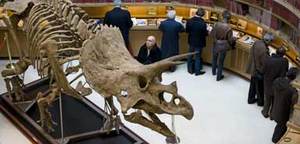
|
| ©Philippe Wojazer/Reuters |
| Whoever buys the Triceratops will get the chance to name it |
Bidding for the skeleton of the huge-headed, three-horned herbivore, one of the last dinosaur species to become extinct, is to start at 500,000 euros (£402,000).
Unearthed from the badlands of North Dakota in 2004, the mud-brown skeleton is 70 per cent complete, a rarity in paleontology, with only the tip of its horns made from resin and a few reconstituted bones in its hind leg. It belonged to an unidentified European collector who had it on display alongside two other dinosaur fossils in his private museum in a chateau, Christie's says.
It is the first time that such a complete dinosaur specimen goes up for public sale since a Tyrannosaurus Rex called "Sue" was sold in New York in October 1997. Sue - named after South Dakota resident Sue Hendrickson, who stumbled on the fossil during a walk - is the most complete T-Rex ever recovered and was bought by the Chicago Field Museum of Natural History for $8.3 million.
The Triceratops is the star lot of the auction that will feature some 150 other pieces: fossils, meteors and minerals, some dating back 450 million years.
The auction follows a first sale of natural history objects at Christie's last year that was criticised for encouraging private collectors to buy up artefacts of potential value to science.
"This is part of our worldwide heritage," said Christian de Muizon, from the National Museum of Natural History in Paris. "You never know what research into a Triceratops skeleton could turn up. If it's in the hands of a private collector, its fate becomes uncertain."
The four-legged 7.5-m (25-ft) Triceratops Horridus, with its large bony frill, has been drawing crowds at Christie's showroom in Paris for the past month while several museum curators and private collectors in Europe and the Gulf states have shown interest.
Among the bidders for the Triceratops Horridus will be the Dinosaur Museum in Dorchester. "It would be a great addition to our museum," said Tim Batty, its curator. "It's a lovely specimen. There really isn't anything like it in Europe."
Batty said an anonymous wealthy sponsor had come forward to help the museum with its bid to have the Triceratops join its current collection which includes a skeleton of a Megalosaurus. The successful bidder will also win the privilege to name the Triceratops.
Also up for bids will be a sabre-toothed tiger cranium, a fossilized giant shark's tooth and a well-conserved skull of an Edmontosaurus, or duck-beaked dinosaur from the late Cretaceous period valued at 70,000 euros.
Several plates of fossilised fish, some dating back 50 million years, are up for auction along with a Tyrannosauraus egg mineralized in agate and an Apatosaurus dinosaur tibia from the Jurassic period.



Reader Comments
to our Newsletter